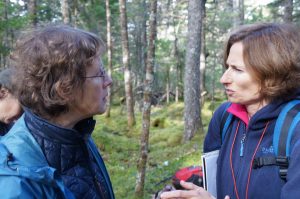
Minga (right) engaged in conversation with soil scientist Elena Ponomarenko at the MTRI Old Forest Conference.
Minga O’Brien, interviewed by CBC Cape Breton for their Breakfast Biography series, said she realized what was so special about our wild lands when she went to Europe as an 18-year old and discovered so little of the forests and streams in the natural state to which we are so accustomed in Nova Scotia.
Minga, amongst many other activities, teaches in the forestry program at the NS Community College in Cape Breton. She is apparently the only certified “Tree Marker” in Nova Scotia. In the interview, Minga talks about what’s involved in Tree Marking and the use of it in Ontario.
The tree marker looks at all trees in a stand or property, evaluates each for a wide range of values, decides which trees can be harvested and which should be left and marks specific trees for harvest. Tree marking is required by law on all crown land in central and southern Ontario, and on a lot of private land. A number of counties have bylaws requiring Tree Marking before cutting trees.
So, says Minga, forestry practices in central and southern Ontario are miles ahead of the rest of the country. The bulk of the harvesting is by selection management and they get far more value added per cubic meter of harvested wood than in any other province; next would be Quebec while Nova Scotia is close to the bottom. These practices generate more wealth and do a much better job of maintaining forest ecosystems in the process.
Minga was asked if she holds hope that the kind of forestry she talked about will one day be practiced here. She believes “a hundred percent” that we could do it, but it would take a huge change in political leadership, in leadership at NSDNR and in our forest economy. She believes we still have the option forest-wise; we have a lot of young stands of Yellow Birch, Sugar Maple, and Ash about 15 cm in diameter; these hold incredible potential for a future forest industry, not for burning but for actual sawmill hardwood flooring, furniture etc… but they are being clearcut or ignored and their potential value is not realized.
Listen to the full interview and wonder as I do why we aren’t promoting such practices in Nova Scotia.
View Ontario Tree-Marking Guide
View Tree By-law Information Package (Ontario)
View Op-ed by Minga (CH Feb 27, 2015): Nova Scotia squanders its forest resources
Listen to: Breakfast Biographies – Minga O’Brien, CBC Nov 10, 2016
